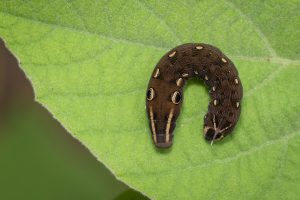Armyworms
Some people may think that armyworms are new inventions, but they have been around for years. They will typically start to crawl when the weather begins warming up and there is a lot of food available on your lawn such as dead grass or leaves. It can be hard to stop these pests from taking over because it depends on how much vegetation you currently have in your yard.

The armyworm has been given its name because of the destructive nature it displays in agriculture, where they are known to consume fields that span across acres. This same behavior sometimes occurs when turf is infested with these pests; areas as large as a football field can be decimated within days. Armyworm infestations can lead to significant damage through defoliation and seed damage, making early detection and intervention crucial.
The name “armyworms” comes from how their behavior looks as if they were invading armies; you’ll see them march across entire farmlands or even over the grass outside! Is there such a thing as armyworm damage? You betcha there is. Sometimes you might find species of armyworms on host plants! Keep an eye out for that as well. Grass pastures are particularly susceptible to infestations, as dense vegetation provides ideal conditions for moths to lay their eggs, increasing the risk of harvest damage.
What do fall armyworms look like?
Fall armyworms are brown and have yellow stripes. The larvae are about an inch long or two. They have four small legs on the thorax, which is their middle section. The first three abdominal segments have faint yellow stripes along the sides but become more distinct on the fourth segment and extend to the orange-colored head and brownish-orange tail in adults. Identifying egg masses, which are typically white or light green and found on the undersides of leaves, is crucial to prevent caterpillars from hatching and causing damage to turfgrass.
Armyworm moths are of a dark gray with light and dark splotches. They have pale hind wings that contrast against their darker front wing colors for camouflage purposes, which is helpful to avoid predators. Adult armyworms can measure up to 1 ½ inches across with brown larvae that range from nearly one inch long to two inches tall in comparison.
One way to tell the difference between these worms is by their stripes. Fall armyworms have none, while all species of worm but this one only have some on each side.
Life Cycle: Three or more generations
There are four life stages for the fall armyworm. The first is an egg, then a larva, then a pupa, and finally an adult. The adult moth has a wingspread of 2 to 4 inches. It is light brown, with the forewings crossed from the outside border along about half of their length by a dark band that extends from the wing tip and tapers to a point. On each side of this band are two small black spots.
The adult moth does not feed but lays eggs in masses of 200 to 500 on lower leaves. These hatch into a larva having a grayish-white body with dark bands along the sides. There is also a dark-brown head and a pair of feathery reddish-brown projections at the rear end. The larvae overwinter in this stage and mature in early spring. Their color varies from grayish white to black, depending on the degree of sunlight exposure they have received. Most are 1 to 3 inches long when fully grown but may grow up to 6 inches. The larval stages are particularly damaging to vegetation, as the larvae feed voraciously on crops, causing significant agricultural damage.
When fully grown, larvae will enter the soil and form the pupal stage. Adult moths emerge from pupae. Moths mate and lay eggs, thus starting the lifecycle over again. Lush plant growth is preferred by the adults for egg-laying. Several generations (A generation is the development from egg to adult stage.) occur each year and typically the life cycle from egg to adult takes 28 days. The life cycle can be extended if cooler temperatures occur and can last up to several months. Under favorable conditions, the life cycle can result in three or more generations per year.
Damage
The severity of fall armyworm damage depends on which plants are available for feeding during each stage of development. After egg laying, armyworm Larvae feeding stages usually occur in the spring and summer. Fall armyworms can cause considerable damage, especially when they feed on small plants such as corn, mustard, and turnips. They may also feed on bulbs, tubers, corms, and rhizomes periodically causing serious problems for commercial growers of these crops. Affected areas can be easily identified by comparing them to sections of healthy turfgrass, highlighting the importance of maintaining healthy grass to effectively manage pest infestations.
Behavior, Diet & Habits: Where do they lay eggs?
Adult armyworms are moths that are less than an inch long. They have a white spot in the middle of each wing. When they lay eggs, they prefer to attach them to leaves on trees. Additionally, adult moths may lay eggs on house siding and fence posts. If you have a lawn, you will usually see damage from this moth starting close to the edges and moving into the middle of your lawn. The larvae will leave brown patches on your grass blades and it can make it look like your lawn is dying or dead.
Caterpillars are the most active during twilight hours when they crawl up to blades of grass and chew on them at a relentless pace. Some people believe that this is simply because it’s too hot out in the day for these little creatures but others point out that even if there were no heat waves, caterpillars would still be able to attack their favorite food source with ease due to how quickly they move from one blade of grass across an entire lawn towards another healthy patch just waiting for its turn under those tiny teeth!
Aside from lawns, the larvae and adults are also known to feed on several wild plants including many weeds. The crop losses from this pest can be high if not controlled early in the season because they consume significant amounts of vegetation, which causes stunting or yellowing of the grasses and forage crops. Cultural management practices such as early grazing, lawn mowing, or cutting grasses and forage crops must be employed on many farms to reduce true armyworm populations.
Control Recommendations
Armyworms are a destructive pest that can spread quickly. If present in large numbers, it’s important to treat as soon as possible or the damage will worsen. There are several active ingredients and variations of formulation for controlling these pests but each has different requirements when applied- be sure you know what your yard needs before buying anything!
The most common method of control for this pest is the use of pesticides. These chemicals are sprayed on plants in hopes of eliminating the potential armyworm infestation before it begins. The use of pesticides is not recommended in vegetable gardens as a precautionary measure. If you are going to use pesticides, it is important to follow the directions carefully and be prepared for any potential side effects and emergency spray removal/cleanup because of injuries or death to pets or livestock that may occur after spraying.
Proper irrigation can make the soil surface cooler and less attractive to armyworms. As an alternative to chemical-based armyworm control on lawns, you can use native predators and prey as a method of biological pest management. These bugs are called “predators” or “prey”; their job is to eat the other bug population! Some examples include spiders, ladybugs, lacewings (pictured), soldier beetles, and praying mantises.
Are army worms harmful?
If you are asking yourself whether or not these fall armyworms are harmful, then you should know that they can hurt your lawn. They will damage the roots of many plants and they can destroy all of the grass in a garden. This means that if they get into a large patch of land, there is potential for serious financial loss. Since they have been known to cause more damage than ants, it is important to take these threats seriously when you see them in your yard or garden.
When do armyworms attack?
The fall armyworm is a pest that usually peaks in late summer or early fall.As the weather begins to get cooler, the fall armyworm develops from last year’s larvae and is ready to start breeding in early springtime. After mating, females begin laying eggs on grasses and other vegetation around mid-summer and continue to lay eggs for the remainder of the summer.
How do I know if I have armyworm infestations?
If you question whether or not you have armyworms, then take a close look at the grass. If there are many small holes that appear to be in straight lines, then it is probably a fall armyworm infestation. The second thing you should do is see if their droppings are present and these will resemble black grains of sand.
If you notice either of these two things in your lawn, then you know that you have an armyworm infestation. Their droppings will look like small black grains and there are a lot of them sprinkled over the grass. You can tell this is not from other sources because they look just like any other type of grain but they have holes in them instead. The next thing you know, your grass will start to disintegrate quickly because of the damage they do to it.
You should also keep in mind that armyworms are only the size of an adult fingernail and their bodies resemble a caterpillar or grub. Their bodies are very small but their appetites are enormous, which means they are going to destroy a lot of grass in your yard. They typically cause the most damage early on and you should start fighting them as soon as possible after spotting any signs of their presence.
How do I treat my lawn for army worms?
These fall armyworms can kill thousands of square feet a day. If you find out if you have armyworm infestation immediately call a professional. A qualified professional will know what insecticide to use and how much of it to apply. He should also know what appropriate Integrated Pest Management protocols to follow.
Will grass recover from armyworms?
Depending on the severity of the infestation, your grass might not recover from a fall armyworm attack. It is important to remember that this attack can do a great deal of damage and it may not seem like they are gone until you notice that there is no longer any grass left in a certain area. If you ever experience this problem, be sure that you know how to fix it before the fall armyworms get too bad.
One thing you can do is to pull out as much of the dead grass yourself so the armyworms have nowhere to hide and be more vulnerable to your control efforts. You should also look for other areas where they might be hiding, such as in leaf piles or under rocks. If you have pets, then you should keep them in the house so they never come into contact with these insects. This will help you prevent any problems before they can ever happen and it may save your lawn from destruction.



